A NEW South Wales beef producer who took part in a recent commercial trial of virtual fencing systems says he can see applications using the technology to reduce expensive fencing and keep stock out of areas that are difficult to muster or control.
John Guest manages Kaluah, a beef cattle property at Tumbarumba on the western edge of the Snowy Mountains in southern New South Wales.
He recently took part in a trial to test new digital agriculture technology, virtual fencing, being developed under the commercial name, eShepherd.
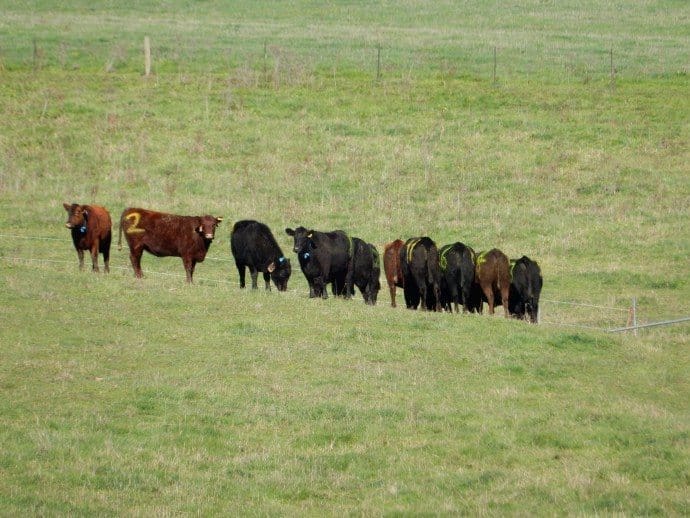
Cattle involved in the Kaluah station trial in southern NSW were kept off a waterway by virtual fencing
Virtual fencing is an animal-friendly system that trains livestock to be confined or moved without using actual fences. Using eShepherd, the producer creates a virtual fence boundary using a smart phone, tablet or computer and the system uses GPS, wireless technologies and sensors to control the location of livestock.
The trial at Kaluah involved a herd of Angus cattle in a paddock with full access to a river and its adjoining land.
“I can see we would use it on our properties to reduce expensive fencing and keep stock out of areas that are difficult to muster or control,” Mr Guest said.
“It’s got the potential to make livestock handling simpler, cheaper and more efficient through so many ways,” he said.
The system works by giving audio cues to cattle through solar-powered smart collars as they approach the fence and a small electric pulse if they continue on. Over a short period of time, cattle learn to turn away when they hear the audio cue. If they do go as far as receiving the pulse, it’s significantly less than the shock of an electric fence. Minimising any stress and ensuring welfare of the animals has been a key part of the research.
For the first week the cattle in the Kaluah trial, with collars fitted but not activated, were able to roam freely in the paddock, cross the river and head into the bush on the other bank. They were monitored and although they were new to the paddock, they got used to drinking at the river each day and grazing alongside it where the pasture is lusher.
eShepherd collars were then turned on, effectively blocking their access. Within a few hours all animals learned the presence of the virtual fence and chose not to enter the waterway zone. Only four cows ‘touched’ the fence – they turned away and thanks to the herd effect, others followed.
“I was surprised how quickly the cattle learnt what the collars were about and after only a few zaps, they just turned away when they heard the audio cue,” Mr Guest said.
Three days into the trial a few animals pushed through the fence but, unlike an electric fence, the system slowly, within around 40 minutes, ‘shepherded’ them back to where they were meant to be.
After eleven days the virtual fence was removed and the animals rapidly returned to grazing along the waterway.
12-years in development
CSIRO started working on virtual fencing in 2005 and over the next five years, became world-leaders, inventing, developing and patenting its world-first, unique system. CSIRO teamed-up with agritech start-up, Agersens, to commercialise the technology, as worldwide licensee and commercial partner.
The aim of the trial at Tumbarumba was to test the effectiveness of keeping the cattle out of an environmentally sensitive area, however there were a multitude of other reasons farmers could use the developing technology, Mr Guest said.
“With the heifers, I look forward to one day being given an alert when they are in trouble and I won’t have to spend hours checking them during calving time,” he said.
“While its most obvious uses are keeping stock out of creeks or where tree lines are being established, the potential management benefits are endless. From rotational grazing and separating bulls, to being able to graze different mobs on the same crop, or reducing weaning stress by slowly moving calves from their mothers while in the same paddock,” he said.
The Tumbarumba trial was supported by Murray Local land Services and Goulburn Broken Catchment Management Authority.
Second break-feeding trial proves successful
Elsewhere, Agersens and CSIRO carried out a break feeding trial in a six hectare paddock in March this year. Break feeding is a system of controlling the feeding of grazing animals by successively allocating pasture or forage crop using a moveable fence.
Six Angus cattle fitted with the eShepherd prototype were first allowed to graze freely over the whole paddock, and as illustrated in the movement record below, preferred to spend time in the shelter of a row of trees at the right-hand end of the paddock.
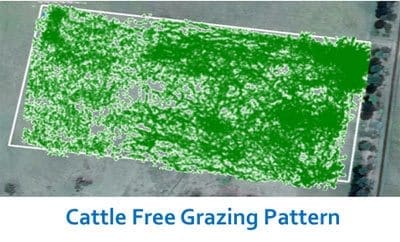
A virtual fence was applied to keep the cattle within 40pc of the paddock area away from the trees. During the two-day training period, as can be seen below, cattle were crossing the fenceline, but being shepherded back into the grazing zone.
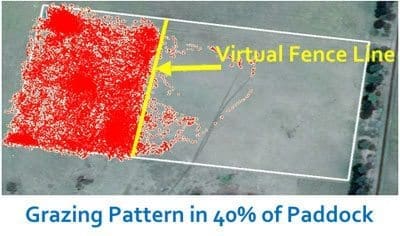
After a few days the cattle were allocated to new pasture by moving the virtual fence 70 metres down the paddock. Cattle moved into the new area within a short time and started grazing on the new pasture.
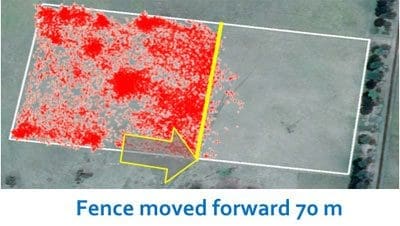
After three days the virtual fence was moved a further 70 metres and the cattle again responded by rapidly moving into the new pasture allocation.
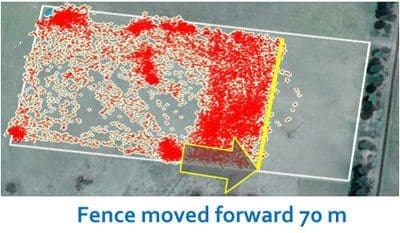
Finally, the virtual fence was rotated lengthwise down the paddock and restricted grazing to a single side.
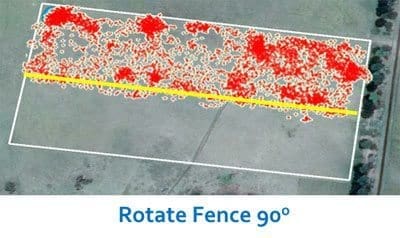
The trial clearly demonstrated that cattle are quick to learn that a virtual fence can be moved, and rapidly adjust to the new position and orientation.
During August, Agersens will start a similar trial on rangeland cattle in Queensland, using the latest collar prototype before scaling up manufacture later this year.
Virtual fencing – Q&As
What is virtual fencing?
Virtual fencing is an animal-friendly fencing system that enables livestock to be confined or moved without using fixed fences. The technology, patented by CSIRO and commercialised by Agersens, uses GPS, wireless technologies and sensors to control the location of livestock without the need for an actual fence.
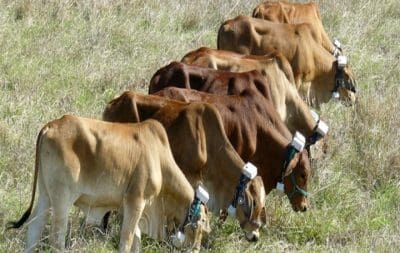 How do animals learn where virtual fences are?
How do animals learn where virtual fences are?
The system uses a unique training program that allows animals to both predict the presence of a virtual fence using associative learning and control the outcome by changing their behaviour. An animal learns to respond to eShepherd just like it learns to avoid a physical fence but by an audio cue rather than a visual cue.
Is it harmful to animals?
No. Healthy, contented animals are important for productive farms and minimising any stress and ensuring welfare of the animals has been a key part of the research. eShepherd has been specifically developed to address animal welfare concerns by focusing on animal behaviour and learning principles. The technology meets the highest animal welfare standards. If the animal does ‘touch’ the fence and receive the pulse, it’s significantly less than the shock from an electric fence. People can even try it on themselves and it feels like a ‘tingle’ on the skin. No physical fence means no barbed wire laceration or injuries to cattle and no possibility of uncontrolled shocking if they were to get tangled up in electric fencing.
Will the animal receive audio cues and electrical pulses if it’s resting on the wrong side of the virtual fence?
No. In this scenario eShepherd does nothing, even if the animal is lying down or standing at the fence boundary. eShepherd responds to behaviour, not just location. Can the animals be shocked inappropriately? No. The collar is controlled using an automated algorithm developed by CSIRO and eliminates the need for unreliable human intervention. Software controls are used to detect and prevent inappropriate use.
Who is developing the technology?
CSIRO started working on virtual fencing in 2005 and over the next five years they became world-leaders, inventing, developing and patenting this world-first, unique system. They teamed up with agritech start-up, Agersens, to help get the technology out to farmers and Agersens are the exclusive, worldwide licensee and commercial partner in virtual fencing. Agersens, recently named one of the world’s top disruptive brands of 2017 for trailblazing in the industry, is also collaborating in NZ applying eShepherd to their conditions.
When will I be able to buy it?
It’s expected that eShepherd will be commercially available in 2018.
Virtual herding:
Other work by CSIRO and Agersens on virtual fencing, also known as virtual herding, is funded by through the Australian Government Department of Agriculture and Water Resources as part of its Rural R&D for Profit program. Further details on this project can be found here.
Source: CSIRO
